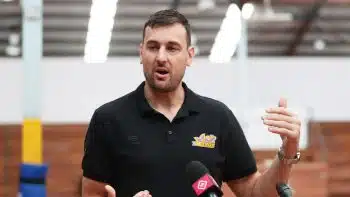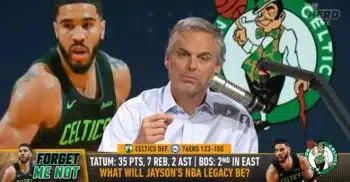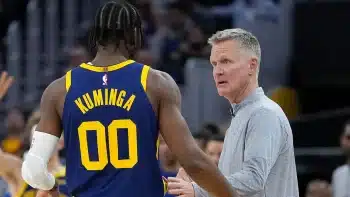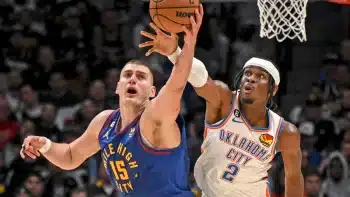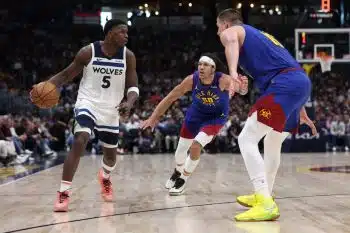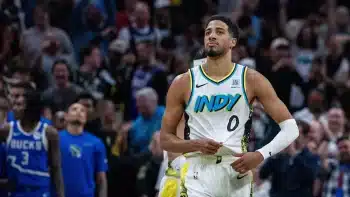NBA
NBA AM: Good Problems? Deciphering Utah’s Depth
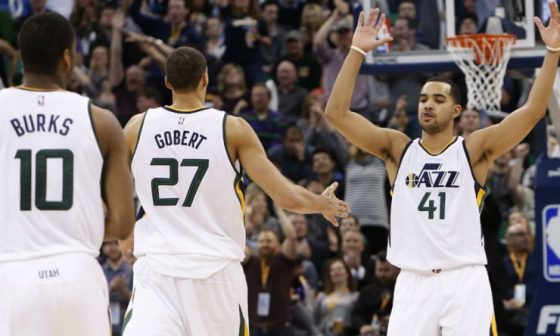
Midway through the third season of the best television show in history, one of the best television villains in history is contemplating a brighter future for himself.
Drug dealer Marlo Stanfield is winning his turf war with rival Avon Barksdale, and preparing for a reality where he might hold more territory and wear the proverbial “crown” of Baltimore hustlers. When an advisor points out that this also means he’ll be faced with more responsibility and pressure, plus rivals gunning for him, Stanfield’s response is among the more iconic lines in the show (warning: video NSFW).
“Sounds like one of them good problems.”
A “good problem” seems a bit like an oxymoron, but Marlo’s point was clear: A brighter future might present a few extra challenges, but they’re well worth the trouble.
And as watchers of The Wire will know, Stanfield did, in fact, hold it down once he took the crown, in some manner of speaking. He wore it longer than anyone else on the show, and was one of the only major characters in his line of work still living when the final credits rolled (plus, as we’re led to assume, he had a pretty nice chunk of change in his pocket for his efforts). A good problem, indeed.
Take away the drugs, the gangster rep, the cold-hearted murders and maybe a few other silly details: Marlo Stanfield and his good problems feel something akin to this season’s Utah Jazz.
Bear with me here.
From the moment the 2016-17 season began, Jazz fans everywhere had at least one eye toward a quickly approaching brighter future. Maybe they weren’t in line for a crown, per se, but only a few nagging injuries stood between them and the realization of a contender several years in the making.
And then a few more nagging injuries pushed the timetable back a little. And then a few more. The Jazz were winning games and staking themselves to a likely playoff spot the entire time, but it was hard to escape the feeling that their real rise lay ahead. With the full clip in tow, so to speak.
Fast forward a month, and it seems like the Jazz may have a few good problems on their hands – but potential problems nonetheless.
They’re still dealing with that same array of now-standard issues, with starters Derrick Favors and Rodney Hood both once again sidelined this week. But with those injuries hopefully minor and the rest of the team finally on the floor together, an interesting question is on the table in Utah: Is there such thing as too much depth?
When everyone is healthy, there’s an argument the Jazz employ 14 NBA rotation-quality players. Some of these are borderline, but look at the track records: Shelvin Mack started 27 games last season (the Jazz went basically .500 in those against a tough Western schedule); Raul Neto started 53 of his own in the same season, at an above-.500 clip; Jeff Withey played nearly 700 minutes, including 10 starts while Rudy Gobert and Derrick Favors suffered overlapping injuries in early 2016; Dante Exum started his entire rookie season for one of the biggest surprise young teams in the league.
With some offseason additions and actual health, though, these guys are often relegated to DNP status. George Hill has stepped into the spot Mack and Exum may have otherwise battled for, and Alec Burks’ return to the lineup after missing nearly all of last season has given coach Quin Snyder the option to play neither of them (or Neto) behind Hill – an option he’s taken the last few weeks. Favors has mostly taken Withey’s backup center role when healthy as Snyder staggers his minutes with Gobert’s and works in guys like Boris Diaw and Trey Lyles.
“You just look at numerically – I think there’s only one lineup that’s played more than 100 minutes together all year,” Snyder said.
He’s right. Only the team’s ostensible starting lineup, a Hill-Hood-Hayward-Favors-Gobert length-fest that’s still somehow been a significant net minus on the year, has crossed the three-figure barrier. There are 75 such lineups in a 30-team league, and the Jazz barely even have one of them.
The NBA isn’t a video game, and player chemistry matters a lot; at the same time, having better players to fill the roles needed on the court is a decided positive. Suddenly, continuity – especially vital in a Snyder system that prioritizes cohesive movement and attention to detail – is beginning to emerge as a real challenge for the Jazz, even with more talent on the floor. Good problems, anyone?
“You’re not going to have some of the instinctive stuff that players have when they’ve played together a lot,” Snyder said. “You have that with individual guys, with combinations. But as you work new people in, that has to develop. It’s not a question of chemistry as much as it is repetition. It’s a good thing that we’re going through this.”
In the long term, there’s no doubt he’s right. The resilience through injury made them stronger, and the ability to keep winning while working major guys back in will do the same. In the present, though, it’s created two interesting rotational quandaries to consider.
Backup Point Guard
As if this one wasn’t already complicated enough with three guys behind Hill on the depth chart, each of whom started games for this team in the last 18 months, Hill’s own various injuries thrust both Mack and Exum into the starting lineup for periods at a time. Both have been relatively all over the place this season, and Snyder has appeared reluctant to use Neto as more than a change of pace.
More recently, with Burks back on the court and returned to a more impressive form than many might have assumed right away, none of the traditional backup guys are getting any run. Burks replaces Hill late in the first and third quarters, and functions as the de facto point guard with bench units.
“When we have that lineup, particularly if it’s Joe Ingles and Alec too, they’re sharing the ball-handling a little bit on some level,” Snyder said. The real emphasis is on the other end, where the Jazz’s backups have badly struggled containing quicker guards this year. “I think [Alec’s] athleticism allows him to be impactful [defending] the ball. His size. It allows us to switch certain matchups.”
It’s a smaller sample, but the Jazz are clearly succeeding in these minutes so far. It seems tough to question that Burks is the best available option currently.
Hanging over all this, though, is Exum’s future. The young Aussie’s absent campaign last year due to an ACL injury is looking more and more damning every day. Instead of entering his second NBA season holding the keys at the point for a franchise still in development mode, he’s in a logjam for backup minutes for a team that wants to win right now.
He’s clearly doing it on a different grading scale than other Jazz youth, too. When a guy like Lyles or Hood makes a glaring schematic mistake (they happen all the time, probably about as often as Exum in Lyles’ case), they may get a talking-to or even a yelling-at. When Exum makes the same mistake, he sits on the bench – often for the rest of the game, and sometimes for games at a time. His confidence is visibly shaken, to the point where it’s become common practice in Jazz media circles to watch for Exum looking back over his shoulder for the incoming sub every time he does something noticeably wrong.
Look, it’s no one but Snyder’s place to address his handling of Exum, something local media has already run him through his paces on. His developmental track record at multiple levels of basketball is beyond even a hint of reproach, and the very real possibility that Exum simply isn’t as good as his draft slot suggests, and might never be, looms over all of this. Snyder’s mandate is different this year, and as sad as it is, Exum’s devastating injury last season isn’t Quin’s fault.
Still, it’s likely the most interesting future subplot in a series of rotational complexities that mostly affect the present. Exum becomes eligible for a rookie extension following this season, and a completely justifiable emphasis on winning games right now is making it more and more likely the Jazz still have very little clue if he’s worth a future investment by the time July rolls around. It’s one of Utah’s current good problems that could turn iffy in a hurry.
Power Forward
Favors hasn’t been completely right all season, and his struggles with nagging injuries and form over the last year and change are at least a little concerning. What’s resulted is a bit of a revolving door at the four spot, with Favors typically starting each half alongside Gobert and then mostly functioning as the backup center after the first set of subs.
Diaw and Lyles both get their turns alongside Gobert each game. While it’s surely due at least in part to Favors’ nagging issues and some noise, both these combos have been better on a per-possession basis than Utah’s presumed starting frontcourt, by over double in Diaw’s case. There have been chunks of time where the Favors-Gobert combo looks too cramped to get buckets against focused defenses, and though their season-long figures are hovering near respectable together, Snyder has been totally unwilling to play them down the stretch in most close games.
Thing is, his best choice between these three options might be…none of them.
The Jazz have played 253 minutes of small ball with Gobert on the floor and no other traditional big men, per nbawowy.com. They’ve scored at a rate just a hair short of the Warriors during these stretches. In the 212 of those minutes where Joe Johnson has been the small four, both Utah’s offense and defense have been better than the league leaders in both categories on the year (again, the Warriors in both cases).
The numbers feel tough to match with the eye test for each of Snyder’s three traditional alignments. Each unit has strong and weak stretches, skewing toward the former, and each seems to have its vulnerabilities. With these small lineups, though, there’s no visible confusion alongside gaudy numbers: Utah is really potent, and there’s a good chance they aren’t sacrificing much defensively against a lot of teams.
There are fewer and fewer true brutes at the four in the NBA these days, and the few who play big minutes are usually giving up more on the other end to guys like Hayward and Johnson. If tweeners want to post those guys up, the Jazz will gladly take most of those looks. Meanwhile, Utah can switch all over the court around Gobert, now spreading his near-literal wings as the league’s most fearsome interior defender.
And if their defensive integrity continues to hold in these small groups, there’s little doubt these are the Jazz’s best looks. This is Gobert’s purest form offensively, a hyperactive screen-setter using his rim runs to vacuum up space for the four above-average three-point shooters dotting the perimeter.
All four can usually run some pick-and-roll, too, and the Jazz can pick on weak defenders regardless of where the opponent hides them – something Snyder can look to more often in a matchup-driven playoff series.
Snyder has noticed how good they are small, and there are times where it feels like he’s resisting the urge to lean on these lineups more at the expense of his three traditional power forwards. And can you blame him? Those guys are each legitimately good!
It’s evident he sees the writing, though: Over half these small minutes come in the fourth quarter, and many have been in high-leverage crunch time moments. As the games get bigger, you wonder how much more he’ll be willing to expand their role. If they’re healthy come playoff time and the roster stays intact, the Jazz have at least five guys they can cycle through the four perimeter spots – six or seven if Snyder can trust Exum or Mack for minutes here or there.
Once again, there are some future ramifications here for these good problems.
Favors is at the center; he hasn’t had the same success minus Gobert, with those lineups mostly treading water even against a lot of bench-heavy units. Untangling his diminished play from his health issues is priority one for the Jazz, but if the answer isn’t encouraging, the clock is ticking.
Lyles is still inconsistent, but he looms as a more mobile, rangy option who provides a cleaner theoretical offensive fit alongside Gobert. Next year will be Favors’ last at his bargain contract before he gets very expensive; his value in a hypothetical trade gets lower every day until then, and even as it feels painfully early to say it, these are the kinds of things Dennis Lindsey and Utah’s front office have to consider.
Maybe this is an overreaction to what are still cloudy data samples, even if the eye test seems to back them up. Lyles is still a long way away in several areas; he’ll cover up a lot of them if he ever hits enough open threes to change the way defenses play him, but he’s taken a big step back there this year. Diaw has stretches where he’s fantastic, and fewer others where he looks his age. It’s possible that balance changes as the year wears on and legs get heavier.
If Favors’ negative indicators are all health-related and turn around soon, there are plenty of ways this works moving forward. Diaw is on a non-guaranteed deal next year, and Snyder’s willingness to use Favors as a center against benches opens up more minutes for more spaced out options around him and Gobert.
The Jazz sit fourth in the West as of this writing; it’s a bit strange to see a team with that much success despite still ironing out so many kinks in the details.
“We’re still finding out about our team,” Snyder said. “It’s a little more discovery. We know our guys – and then you have to continue to see how they play and fit together.”
These have been good problems so far, but even some good problems might need solutions. The next few months will be telling for one of the league’s deepest and most complicated teams.
